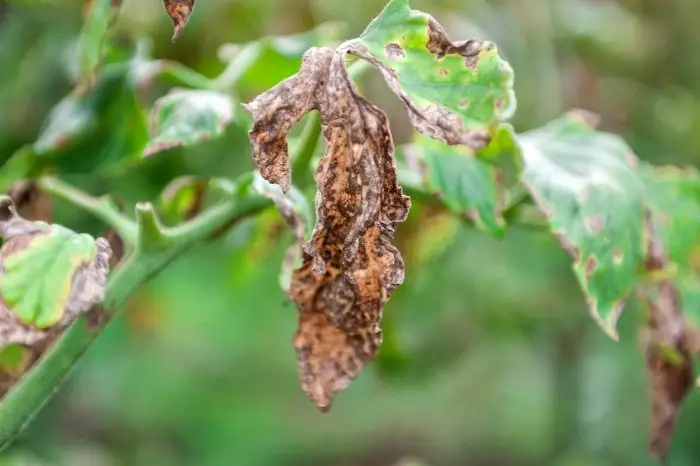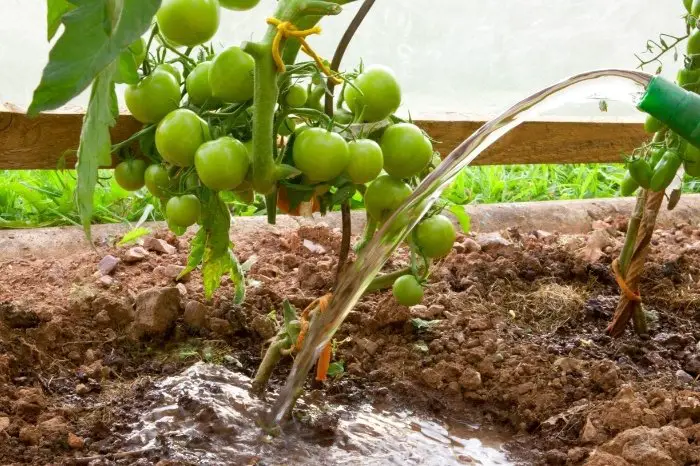Last Updated on December 6, 2021
Septoria leaf spot-resistant tomatoes are a prevalent disease affecting tomato plants and other plants like eggplants and potatoes.
This leaf spot is not necessarily fatal, but it spreads rapidly and quickly defoliate and weakens your plants making them unable to bear fruit.
Signs Of Septoria Leaf Spot-Resistant Tomatoes
Tomato septoria leaf spots start as a circular spot on the undersides of older leaves at the bottom of the plant. These spots have a dark brown margin and lighter grey centers. A yellow color may surround the area, which is about 1.6 to 3.2 mm.
As the septoria tomatoes leaf spots develop, the areas get larger by merging. When viewed under a magnifying glass, you will see the fungus that looks like dark brown pimples. This sign distinguishes the septoria-resistant tomatoes leaf spot from other leaf spotting diseases.

This disease can occur at any stage in tomato plants’ life, although it commonly happens in the older stages of a tomato plant. These spots may also appear on the stems or the blossoms. However, they do not affect the fruits.
The septoria leaf spot-resistant disease spreads rapidly across your tomato garden. If left untreated, the septoria leaf spot causes the leaves to turn yellow, dry out, and fall off. This weakens the plant and sends it into decline. This plant will not continue producing or maturing the exposed tomato fruits.
How Does Septoria Leaf Spot-Resistant Disease In Tomatoes Spread
The fungus spores that cause this disease are very good at hiding and waiting for the best conditions to thrive. They thrive in temperatures ranging from 59 to 80 degrees Fahrenheit. They can travel great distances in the hope of finding the right conditions.
The septoria fungus leaves on the fallen tomato plants the breeze or weeds that have carried the disease before. It also overwinters successfully on its own, meaning that change of weather does not kill this fungus.
Splashing water while watering your tomato plants is a common way to spread this fungus. Insects like beetles or your hands and clothes can also spread it.
If the conditions are moist and favorable, it only takes 2 weeks for your entire garden to be fully infected.
The spores can quickly germinate within 48 hours in the leaf spots develop in as little as 5 days. The pycnidia appear within 7 to 10 days, and the fungus can produce small spills within 10 to 13 days.
Spores do not infect the plants unless there’s free moisture, so infections are low during the dry days but are more likely to escalate on rainy days.
Several plants in the nightshade family are vulnerable to this infection and serve as potential hosts, including potatoes and eggplant. Common weeds like horsenettle, nightshade, jimson weed, and smooth ground cherry. They can produce even more spores and infect your tomato plants easily.
How To Treat Septoria Leaf – Spot Resistance On Tomatoes
There are a few options for treating this disease. They include:
-
- Removing the Infected Leaves or Plants Immediately. Immediately you notice infected leaves remove them immediately, and be sure to wash your hands and pruners thoroughly before touching an infected plant.
- Use Chemical Fungicides. Even though these options are not ideal, they could be the only option for controlling advanced septoria infections. Choose the least toxic and most effective fungicides in the market.
- Consider Using Organic Fungicide Options. Organic fungicides containing potassium bicarbonate or copper will help prevent the spreading of this disease. As soon as you notice the first symptoms, begin sprain and follow the label instructions for continued management.
Preventing Septoria Leaf Spot-Resistant On Tomatoes
It is sometimes hard to avoid septoria leaf spot altogether because it is prevalent and requires the ideal conditions to thrive. However, there are some precautions you can take to lower the likelihood of septoria leaf spots from occurring
Use Disease-free Seed
This fungus can be passed on by seeds. To be on the safe side, don’t save seeds from infected plants. If you’re keeping your tomato seeds, it is best to thoroughly process them to help get rid of any lingering strains of the disease.
Start Your Crop In A Clean Garden
After harvesting, dispose of all the affected plants. This fungus has been strong enough to overwinter on the remains of dead plants for many years. Therefore, it is essential to dispose of all the affected plants far away from the garden and not to add them to your compost pile. Be sure to dispose of it away from any eggplants or potatoes you could be growing.
Provide Room For Air Circulation
When growing your tomatoes, leave some space between your tomato plants so that there’s good airflow. Hang them for support, so they’re not touching the ground and are not all bunched up together. Good air circulation is critical during damp or rainy weather.
Avoid Overhead Watering
Water is one significant way that the septoria leaf spot spreads. Keeping water off the leaves when you irrigate is essential and only watering the base of the plant. Yes, it’s impossible to keep the rain off your plants, but every bit of caution helps.

Mulch Below The Plants
A layer of mulch helps prevent spores that are on the ground from splashing up onto the lower leaves during watering.
Plant Your Next Season Of Tomatoes In A Different Section Of Your Garden
Practice crop rotation so that you avoid getting your new tomatoes infected with the septoria leaf spot.
Final Thoughts
The only way to defeat the septoria leaf spot resistance in tomatoes is to spot it immediately. If you are a constant tomato farmer, septoria leaf spot can be a severe problem for your tomatoes if not dealt with.
The fungus does not infect the fruit, but the infection could result in poorly developed tomatoes and ruin your crop? If this disease strikes your plants, you may use fungicides to keep it under control despite your efforts to prevent the infection.
Be on the lookout for this leaf infection and deal with it as soon as you notice it!

Lory is an avid gardener who loves spending time outdoors. She is passionate about using her green thumb to create beautiful, lush gardens for her friends and family. She finds joy in tending to her garden, trimming plants, and cultivating new species. She loves to share her knowledge and experience with others who have a similar enthusiasm for gardening. Lory is a true nature enthusiast who loves to share her enthusiasm for the outdoors with all who meet her.

